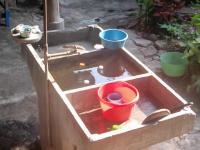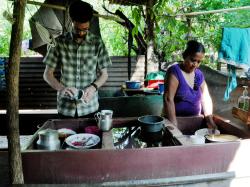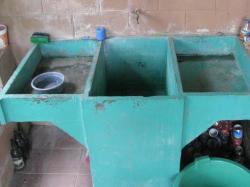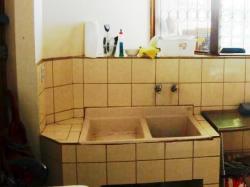Estimated Reading Time: 5 Minutes

Like you don’t know how to do your laundry, right? Well, the best way to do your laundry in Costa Rica is to hire a maid and have her do it.
I have written lots of blogs about the difference in culture between back home and Costa Rica and I thought it was time to tell you what you can expect to find to do your laundry in Costa Rica.
In this blog, you will find all about washers and dryers and how the laundry is done in Costa Rica. It sounds a bit strange, but there is definitely a difference between living in a city or a rural area in Costa Rica and between living in a single-family home or a condo.
The washer
Let’s first start by telling you all about washers in Costa Rica. Technology has also arrived in Costa Rica but mostly in the cities. A lot of people living in the rural areas of Costa Rica, still wash by hand. That’s why all homes have a “pila”. A pila (the word pila in Spanish also means battery) is usually a concrete sink in the washroom/laundry room.
This concrete sink normally has two different sized sinks, one deep and one shallow, with a faucet over the deep side. The deep sink is used to wash your floor mop or let your dirty clothing soak for a while or wash it. The shallow sink is used to scrub your underwear, lingerie, and other clothing. Originally, the cement to make the pila was mixed with ochre, so they  were red but in the ’80s the homeowners started to make them nicer and nicer as you can see in the different photos in this blog.
were red but in the ’80s the homeowners started to make them nicer and nicer as you can see in the different photos in this blog.
Older rural homes in Costa Rica might not have a normal kitchen sink and they have a pila. In such a case, a pila has three sinks, with a deep sink in the middle and two shallow ones to the side. The faucet is over the deep sink.
The construction of condominiums and apartments in Costa Rica started only 10 years ago, so they are all completely modernized. You will find condominiums in the cities around San Jose and in large beach towns. To save space, condos have either a very small pila and might have space for a side-by-side washer & dryer or just space for a stack washer & dryer. Most of these pilas are now made of plastic.
Hot water
Most rural homes and lower-end homes in the city don’t have hot water throughout, more about this in another blog. But most pilas do not have hot water, only cold. Modern times are bringing the instant heater systems also to the pilas as they are easy to install without having to run hot water  pipes from other places in the home.
pipes from other places in the home.
The dryer
Let me start by telling you that the use of a dryer is influenced by the weather in Costa Rica and the fact that the people get up before dawn. Strange eh!
A Tico doesn’t need a dryer; they have the sun and the wind to dry their clothing. Our dry season is about half the year and the other half it almost never rains early in the morning. Ticos get up before dawn and generally do their laundry even before breakfast. My wife switches on the washer before we go to the gym at 6 am. When the maid arrives before 7 am, she hangs it outside and it’s dry within the hour. We only use our dryer a couple of times in the year, when it rains too much to get it dry.
The patio de pilas
Just like they have a pila in their laundry room, homes in the city also have a “patio de pilas”. This is a small courtyard that is attached to the laundry room, full of clotheslines, where they can hang their clothes out in the sun and wind.
In the rural areas, you will find a lot of people hanging their clothes to dry on the fence, no matter if it’s a barb wire fence or any other material.
Buy a home with any of the GoDutch Realty agents and you’ll be fully informed what kind of laundry room your new home in Costa Rica has and how to get your laundry done without getting hurt.
If you like this blog, subscribe to my newsletter by clicking the banner below.
I DO want to remind our readers that we appreciate any referrals you can send us. Also, remember GoDutch Realty when talking about your home in Costa Rica to friends and family. We appreciate it.

























